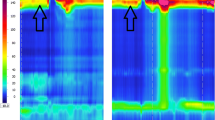Abstract
The change in pressure of competent and incompetent lower esophageal sphincter (LES) due to abdominal compression is still a controversial subject. Therefore, we studied the effect of sustained (SAC) and intermittent (IAC) abdominal compression on lower esophageal sphincter pressure (LESP) in normals (N), patients with hiatus hernia (HH), and patients with scleroderma (S). When resting lower esophageal sphincter pressure exceeded 15 mm Hg, response to SAC and IAC was similar in patients with HH and in normals. On the other hand when basal LESP was below 15 mm Hg, stimulated sphincter pressure during IAC was significantly lower than during SAC. Values recorded during SAC were also falsely high in patients with scleroderma. Values obtained during either SAC or IAC did not depend on presence or absence of reflux symptoms in any group. LES stimulation with IAC gives valid results which correlate closely with LESP. Stress tests with IAC therefore seem to be a useful stimulation test for the analysis of LES function.
Similar content being viewed by others
References
Fyke FE Jr, Code CF, Schlegel JF: The gastroesophageal sphincter in healthy human beings. Gastroenterologia 86:135–150, 1956
Nagler R, Spiro HM: Segmental response of the inferior esophageal sphincter to elevated intragastrine pressure. Gastroenterology 40:405–407, 1961
Van Derstappen G, Texter GC Jr: Response of the physiologic gastroesophageal sphincter to increase intra-abdominal pressure. J Clin Invest 43:1856–1868, 1964
Henderson RD, Rodney K: Tone of the gastroesophageal junction: Its response to abdominal compression and serallowing. Can J Surg 14:328–334, 1971
Dodds WJ, Hogan WJ, Niller WN, Stef JJ, Arndorfer RC, Lydon SB: Effect of increased intraabdominal pressure on lower esophageal sphincter pressure. Dig Dis Sci 20:298–308, 1975
Christensen J: Gastrointestinal Motility, Raven Press, New York, 1980.
Lind JF, Warrian WG, Wankling WJ: Responses of the gastroesophageal junctional zone to increases in abdominal pressure. Can J Surg 9:32–38, 1966
Harris LD: Gastrointestinal Motility. Academic Press New York, 1971
Cohen S, Harris LD: Lower esophageal sphincter pressure as an index of lower esophageal sphincter strength. Gastroenterology 58:157–162, 1970
Weihrauch ThR: Esophageal Manometry. Urban and Schwarzenberg, München, 1981
Förster CF, Weihrauch ThR, Brummer A, Vallerius P, Lehmann H: A new electronic transducer system for gastrointestinal pressure studies. Med Progr Technol 4:169–175, 1977
Kaye MD, Showalk JP: Manometric configuration of the lower esophageal sphincter in normal human subjects. Gastroenterology 61:213–223, 1971
Author information
Authors and Affiliations
Rights and permissions
About this article
Cite this article
Janisch, H.D., Weihrauch, T.R. & Hampel, K.E. Is abdominal compression a useful stimulation test for analysis of lower esophageal sphincter function?. Digest Dis Sci 29, 689–695 (1984). https://doi.org/10.1007/BF01312939
Received:
Revised:
Accepted:
Issue Date:
DOI: https://doi.org/10.1007/BF01312939




